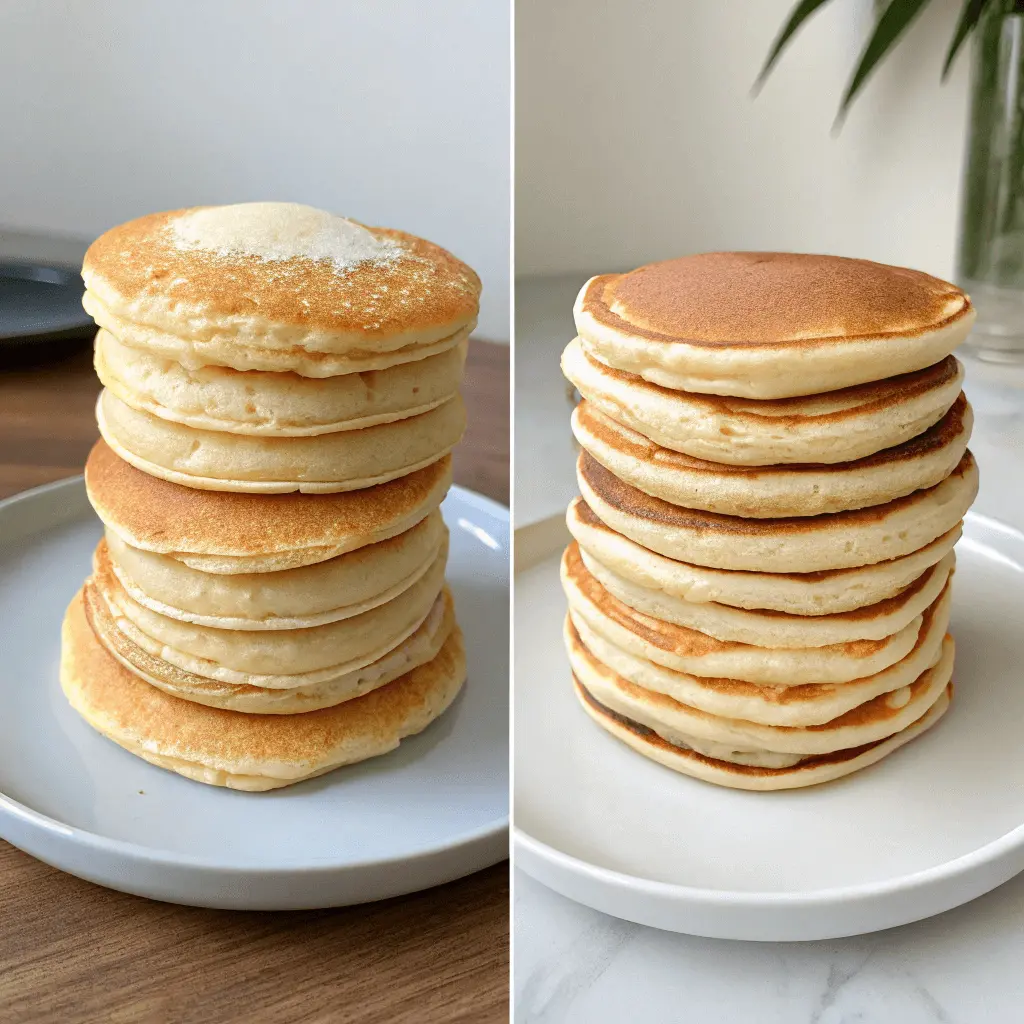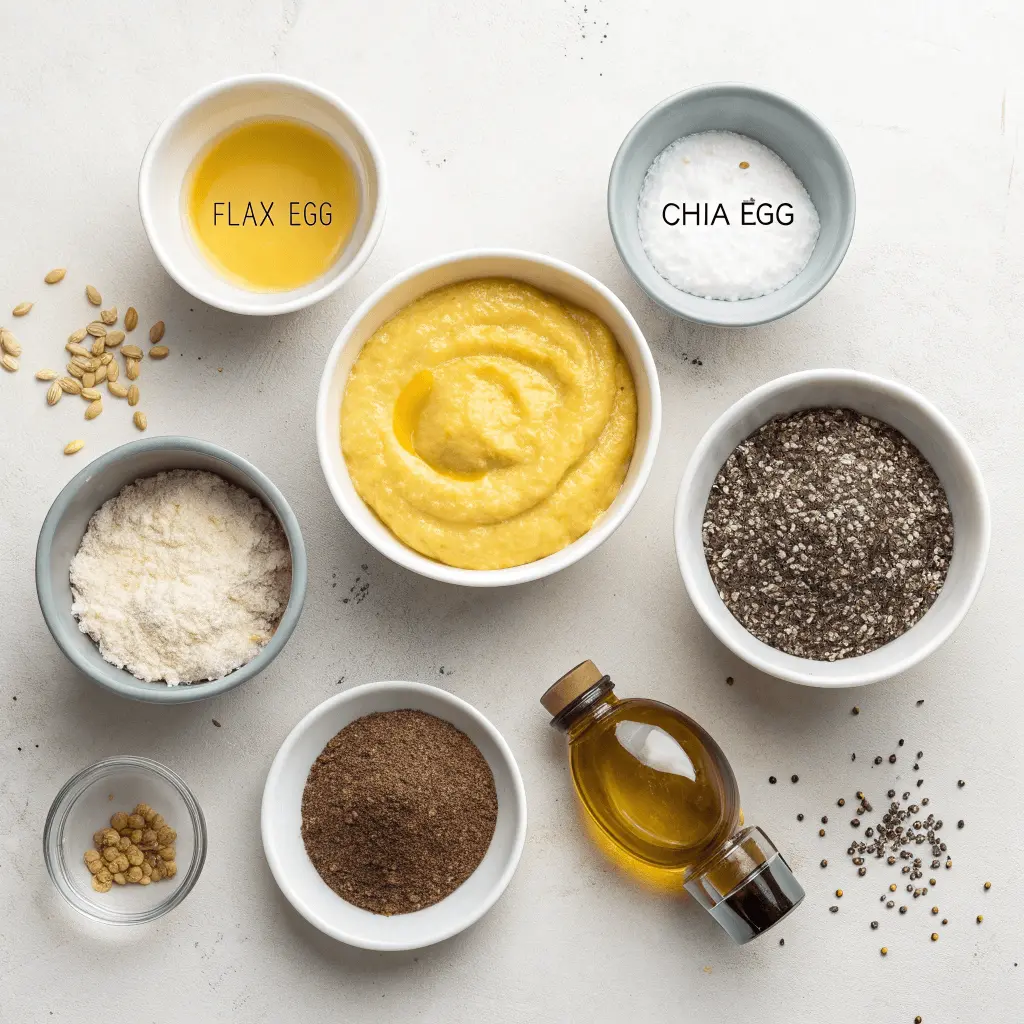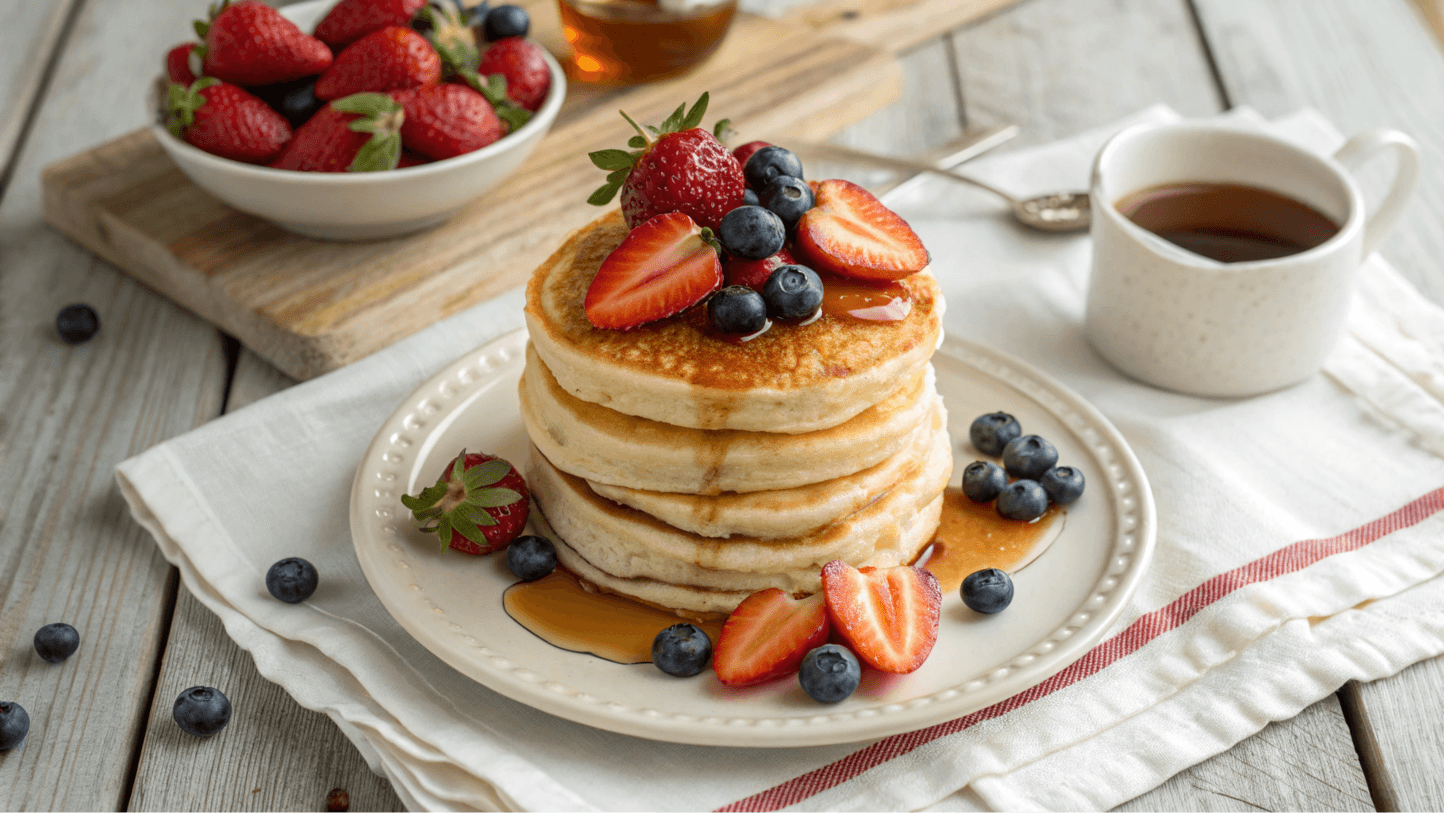What can I use if I don’t have eggs for pancakes? That was the exact question swirling in my mind one lazy Sunday morning. I had my skillet ready, the craving for fluffy pancakes in full force—but my fridge was completely egg-free. I stared at the pantry, determined not to give up on breakfast. That’s when I discovered a whole new world of clever substitutions and simple tricks that saved the day.
Whether you’re facing the same dilemma, managing dietary restrictions, or simply looking for a creative kitchen hack, you’re in the right place. In this guide, we’ll explore why eggs matter in pancake recipes, which substitutes actually work, and how to make perfect pancakes—no eggs needed. Let’s turn that eggless setback into your best batch yet.
Table of Contents
Why Eggs Matter in Pancake Recipes
If you’ve ever asked yourself, what can I use if I don’t have eggs for pancakes, it helps to first understand why eggs are such a staple in traditional pancake recipes. Eggs play multiple roles that impact texture, structure, and taste.

How Eggs Contribute to Pancake Structure & Texture
Eggs are true multitaskers in pancakes. They help with:
- Binding: Eggs hold the batter together, preventing your pancakes from falling apart.
- Moisture: Eggs add richness and moisture, keeping pancakes tender inside.
- Leavening: The proteins in eggs trap air, helping pancakes rise and stay fluffy.
- Color & Flavor: Eggs contribute a light golden color and mild richness to the batter.
Fun fact: Without eggs, pancakes can turn out dense, flat, or crumbly if not adjusted properly.
What Happens When You Skip Eggs
So, what can I use if I don’t have eggs for pancakes—and what goes wrong without them? If you omit eggs without a replacement, you might notice:
| Issue | Why It Happens |
|---|---|
| Pancakes fall apart | Lack of binding agent |
| Dense or gummy texture | Missing leavening and structure |
| Dry, crumbly pancakes | Eggs’ moisture contribution is missing |
| Flat appearance | No protein lift or air-trapping properties |
That’s why choosing the right egg substitute is essential to mimic these effects and keep your pancakes delicious!
For deeper insights on how eggs impact pancake recipes, check out what happens if you don’t put eggs in pancakes—a must-read to understand the science behind fluffy stacks.
Top Egg Substitutes for Pancakes (With Pros & Cons)
So you’re asking, what can I use if I don’t have eggs for pancakes? The great news is there are plenty of alternatives that work beautifully. Some substitutes are perfect for adding moisture, while others help bind the batter or even mimic the fluffiness that eggs usually provide.

Applesauce, Mashed Banana & Yogurt
These are some of the most popular egg substitutes for pancakes, especially if you love a slightly sweet twist.
- Applesauce: Use ¼ cup of unsweetened applesauce per egg. It keeps your pancakes moist and adds a subtle apple flavor.
- Mashed Banana: ¼ cup of ripe banana works well to bind the batter and adds natural sweetness—great for breakfast lovers!
- Yogurt (Plain or Greek): ¼ cup per egg adds creaminess, moisture, and a rich texture. Best for fluffy, tender pancakes.
| Substitute | Pros | Cons |
|---|---|---|
| Applesauce | Adds moisture, mild taste, vegan-friendly | Can make pancakes denser |
| Mashed Banana | Sweet, binding, easy to find | Distinct banana flavor may dominate |
| Yogurt | Creamy, binds well, boosts fluffiness | Not vegan unless using plant-based yogurt |
Tip: These options are fantastic when you want a little extra flavor and a moist texture in your pancakes.
For a vegan twist, flax eggs and chia seeds work wonders. Want a neutral flavor? Aquafaba (the water from a can of chickpeas) is excellent for fluffiness. Get a step-by-step guide for optimal results in the ultimate guide to perfect pancake recipe without eggs.
Vegan-Friendly Options: Flax Eggs, Chia Seeds & Aquafaba
For a plant-based or allergy-friendly option, these are the go-to substitutes:
- Flax Egg: Mix 1 tablespoon of ground flaxseed with 3 tablespoons of water. Let it sit for 5–10 minutes until it thickens into a gel. Great for binding.
- Chia Seed Egg: Same ratio as flax. Chia seeds swell and create a gel-like texture that holds the batter together beautifully.
- Aquafaba (Chickpea Water): 3 tablespoons of aquafaba equals one egg. It’s amazing for adding lightness and works surprisingly well in pancakes.
| Substitute | Pros | Cons |
|---|---|---|
| Flax Egg | Excellent binder, nutty flavor, rich in fiber | Slight grainy texture |
| Chia Egg | High in omega-3s, great binder | Can create a speckled look in the batter |
| Aquafaba | Light and airy, perfect for fluffy pancakes | Slightly unusual to find if not on hand |
Pro Tip: If you’re looking for a neutral flavor and a reliable rise, aquafaba is worth trying.
Quick Pantry Fixes: Vinegar + Baking Powder, Oil Combos
What if you have no specialty ingredients? No worries—your pantry might already have a solution:
- Vinegar + Baking Powder: Mix 1 tablespoon of vinegar with 1 teaspoon of baking powder per egg. This combo activates bubbles in the batter and helps pancakes rise.
- Oil + Water + Baking Powder: Use 1 tablespoon oil, 2 tablespoons water, and ½ teaspoon baking powder for a simple fix that adds moisture and helps leaven the batter.
| Substitute | Pros | Cons |
|---|---|---|
| Vinegar + Baking Powder | Light, fluffy pancakes, easy ingredients | Doesn’t bind well—pair with another binder |
| Oil + Water + Baking Powder | Adds moisture and rise | Needs careful measuring to avoid greasiness |
Bonus Tip: These quick fixes are perfect when you’re in a pinch and wondering what can I use if I don’t have eggs for pancakes with basic ingredients.
Speaking of oil, if you’re considering using oil as a substitute, our detailed article on is oil a substitute for eggs in pancakes will help you decide if that’s your best bet
How to Pick the Right Substitute for Your Needs
If you’re still asking yourself, what can I use if I don’t have eggs for pancakes, the answer really depends on what kind of pancakes you want to make. Not every substitute works the same, so choosing the right one can make a big difference in texture, flavor, and overall success.
Matching Substitutes to Pancake Type (Fluffy, Thin, Vegan)
Different substitutes work better depending on the style of pancake you’re making:
- For Fluffy Pancakes: Choose substitutes that add lift, like aquafaba or vinegar + baking powder. These mimic the airy texture eggs usually provide.
- For Thin or Crepe-Style Pancakes: Go for moisture-rich options like applesauce or yogurt. These keep your batter smooth and spreadable.
- For Vegan Pancakes: Flax or chia eggs are your best bet for binding while keeping everything plant-based.
Tip: If texture matters most to you, flax eggs or aquafaba are top picks for closely mimicking eggs’ structure.
Flavor, Texture & Allergen Considerations
Think about your dietary needs and taste preferences before choosing a substitute:
- Flavor: Want a neutral taste? Go with yogurt or aquafaba. Craving something a bit sweet? Mashed banana or applesauce adds a natural fruity note.
- Texture: Need soft and fluffy? Opt for yogurt or a combo of oil + baking powder. Want something denser for hearty pancakes? Flax eggs are a good match.
- Allergens: Avoiding dairy? Skip yogurt. Need nut-free? Choose applesauce or aquafaba.
| Need | Best Substitute Options |
|---|---|
| Neutral flavor | Yogurt, aquafaba |
| Slightly sweet | Applesauce, mashed banana |
| Vegan & plant-based | Flax egg, chia egg, aquafaba |
| Extra fluffy texture | Vinegar + baking powder, aquafaba |
Best for Emergency Substitutions (No Specialty Ingredients)
If you’re caught in a pinch and wondering what can I use if I don’t have eggs for pancakes with only basic pantry staples, these are lifesavers:
- Vinegar + Baking Powder Combo: Always reliable if you have no fancy ingredients.
- Oil + Water + Baking Powder: A simple fix when you need moisture and a bit of lift.
Pro Tip: When using emergency substitutes, monitor your batter’s thickness and adjust with a splash of milk or water to keep things balanced.
Step-by-Step Guide: Making Pancakes Without Eggs
Once you know what can I use if I don’t have eggs for pancakes, the next step is making sure your pancakes come out light, fluffy, and delicious. This simple step-by-step guide walks you through the process from start to finish.
Essential Ingredients & Tools
Here’s a basic list to prepare your egg-free pancakes:
Ingredients:
- 1 cup all-purpose flour
- 1 tablespoon sugar (optional)
- 1 tablespoon baking powder
- ¼ teaspoon salt
- 1 cup milk (dairy or plant-based)
- 2 tablespoons oil or melted butter
- Egg substitute of your choice (for example, ¼ cup applesauce or a flax egg)
Tools:
- Mixing bowl
- Whisk or fork
- Non-stick skillet or griddle
- Spatula
Tip: Choose a neutral-flavored oil or butter to keep the pancake taste classic.
How to Mix & Adjust the Batter
- Combine Dry Ingredients:
In a large bowl, whisk together the flour, sugar, baking powder, and salt. - Prepare Your Egg Substitute:
If using flaxseed, mix 1 tablespoon ground flaxseed with 3 tablespoons water and let it sit until it forms a gel-like texture. - Mix Wet Ingredients:
In a separate bowl, combine the milk, oil or melted butter, and your prepared egg substitute. - Combine Wet and Dry Ingredients:
Pour the wet mixture into the dry ingredients. Stir gently until just combined. It’s fine if the batter has a few lumps; overmixing can make the pancakes tough. - Adjust the Batter:
If the batter seems too thick, add a bit more milk. If it is too thin, stir in a tablespoon of flour to thicken it up.
For a creative twist, learn whether it’s safe to nibble on the raw batter with our post on can you eat pancake batter without an egg.
Cooking Tips for Fluffy Egg-Free Pancakes
Preheat your skillet or griddle over medium heat. Lightly grease the surface with oil or butter before cooking each batch.
Scoop about ¼ cup of batter for each pancake and pour it onto the heated surface. Watch for bubbles forming on the surface and the edges setting, which usually takes 2 to 3 minutes. Carefully flip the pancake and cook for another 1 to 2 minutes until golden brown and cooked through.
For the best results, keep the cooked pancakes warm by placing them on a baking sheet in a low oven (around 200°F) while you cook the remaining batter.
Troubleshooting Eggless Pancake Problems
If you’ve tried making pancakes without eggs, you might have run into some common issues. Knowing what can I use if I don’t have eggs for pancakes is just the first step—getting the texture and flavor right is the real challenge. Here’s how to troubleshoot and improve your results.
Why Pancakes Are Flat or Gummy
Eggs help create fluffy, airy pancakes by trapping air and supporting the batter’s structure. Without eggs, these problems can occur:
- Flat Pancakes: This often happens because the batter lacks lift. Without eggs, the pancakes might not rise properly, leading to a thin, dense result.
- Gummy or Sticky Texture: This is usually due to too much moisture or undercooking. Eggless batters can be trickier to cook through evenly.
- Crumbly Pancakes: When there’s no proper binding agent, the pancakes may fall apart easily, especially during flipping.
Understanding these causes makes it easier to fix problems quickly.
Tips to Improve Rise, Texture & Flavor
To get eggless pancakes that are just as good as the original, follow these tips:
- Boost the Leavening: Add an extra ¼ teaspoon of baking powder or a pinch of baking soda to encourage more rise.
- Choose the Right Binder: Use flaxseed, chia seed, or a bit of mashed banana to help hold the batter together and avoid crumbling.
- Adjust Cooking Time: Cook egg-free pancakes a bit longer over medium-low heat. This allows the inside to cook fully without burning the outside.
- Enhance the Flavor: Add a teaspoon of vanilla extract, a sprinkle of cinnamon, or a bit of lemon zest to bring out more depth in flavor, compensating for the mild taste eggs typically add.
- Test the Batter: If your batter looks too runny, stir in a bit more flour. If it’s too thick, add a splash of milk to reach the right consistency.
Tip: Let the batter rest for 5 to 10 minutes before cooking. This allows ingredients to fully hydrate, improving texture and making the pancakes easier to flip.
FAQs:
When searching for alternatives, questions like “What can I use if I don’t have eggs for pancakes?” often come up. Here are answers to some of the most common queries:
Can I Make Pancakes Without Eggs and Milk?
Yes, you can! Replace eggs with flax eggs or applesauce and use a plant-based milk alternative like almond, oat, or soy milk. These swaps create pancakes that are both dairy-free and egg-free without sacrificing texture or flavor.
What Is the Easiest Egg Substitute for Pancakes?
The easiest substitute is unsweetened applesauce, which is likely already in your kitchen. Use 1/4 cup of applesauce per egg in your recipe for a hassle-free and effective alternative.
Are Egg-Free Pancakes as Fluffy as Regular Pancakes?
Egg-free pancakes can be just as fluffy if you use the right substitutes. Leavening agents like baking powder or vinegar paired with baking soda create the bubbles needed for lift. Resting the batter for a few minutes also helps enhance fluffiness.

